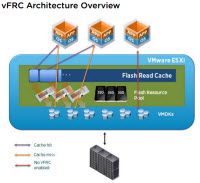New whitepaper which has been released by VMware brings details about new feature present in vSphere 5.5 – vFlash Read Cache (VFRC). I already reported on the details about VFRC in my article – VMware vSphere 5.5 vFlash Read Cache. The paper brings more details about vFlash Read Cache Performance through much deeper testing with different workload characteristics, different cache size and different cache block size.
You'll find all the results and charts which shows that the VFRC allows 50% of improvements almost in most cases. It's a technical performance paper. The performance depends on the SSD drive size, the application behavior (reads vs writes ratio) and cache block size. Importance is to set the cache block size which matches the application to have less evictions and more cache hits.

Higher cache block sizes are not better in terms of performance and efficient management of cache space. As cache evictions and cache fills happen in the granularity of a cache block size, if the cache block size is much higher than the typical I/O size, there might be a situation where an additional amount of already cached data needs to be evicted to store a small amount of new data. For example, consider a cache with a cache block size of 64KB. Assuming there are no free blocks in the cache to hold new data, when a 4KB I/O arrives from the guest VM, if there is a cache miss, 64KB of cached data would have to be evicted to hold the new 4KB data. This leads to sub-optimal management of cache space and may reduce the overall cache hit rate for the workload
Another point which did not really surprised me, but the fact that PCIe Flash cards are several times faster than usual SATA or SAS flash based hard drives.
There is an example:
Micron P320h PCIe flash drive is rated to service a sustained random read IOPS of around 750K [1], while an Intel 6Gb/s SATA 320 SSD is rated to service at 39.5K IOPS for random reads.
I think I would also mention that vFRC is available through enterprise plus licensing only, which makes this feature suitable for larger enterprise customers rather than customers running vSphere Essentials or Essentials Plus.
Here is the (correct) Download Link.
